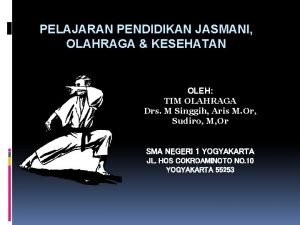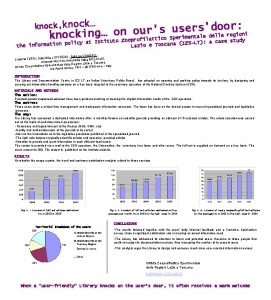KNOCKOUT ANIMALS GENE KNOCK OUT TECHNOLOGY Knocking out












- Slides: 12

KNOCKOUT ANIMALS

GENE KNOCK OUT TECHNOLOGY • Knocking out an existing gene by replacing it or disrupting it with an artificial piece of DNA. • Knockouts are used to study the function of specific genes. • A conditional knockout allows gene deletion in a tissue specific manner • Simultaneously knocking out : 2 genes → double knock out 3 genes → triple knockout 4 genes → quadruple knockout

Researchers who developed the technology for the creation of knockout mice won Nobel Prize in the year 2007. They developed knock-out mice in 1989 Mario. R Capecchi Sir Martin J. Evans Oliver Smithies

A laboratory mouse in which a gene affecting hair growth has been knocked out (left), is shown next to a normal lab mouse

ANIMAL KNOCK-OUT MODELS • Knockout mice are a common tool for studying genes in the laboratory. • Microorganisms are also used for studying gene function. • The knockout can be lethal.

HOW IT WORKS? • With the use of recombinant DNA technology cloned genes are modified in such a way that they are no longer functional. • Cloned genes modified in this way are known as ‘Knock out construct’. • When homologous recombination occurs with a knock out construct, the non-functional knockout allele replace the endogenous mild type allele.

PROCEDURE • The gene to be knocked out is isolated from a mouse gene library • Then a new DNA sequence is engineered • The new sequence is also given a marker gene. • Stem cells are isolated from a mouse blastocyst. • The new sequence is introduced into the stem cells by electroporation • The stem cells that incorporated the knocked-out gene are isolated and inserted into a mouse blastocyst. • These blastocysts are then implanted into the uterus of female mice

The newborn mice will therefore be chimeras. These chimera mice are crossbred with others of the wild type. The mice produced are not chimeras, but they are still heterozygous. When these heterozygous offspring are interbred, some of their offspring will inherit the knocked-out gene from both parents.

KNOCKOUT MOUSE GENE IN ES CELLS

APPLICATIONS • To determine the function of gene products • To create mouse models of human genetic diseases • To characterize genetic regulatory regions.

Cystic Fibrosis and Gene Knock-out Technology The human Cystic Fibrosis gene is identified and cloned in a phage vector. ES cells are recoverd from mouse blastocyst. Transfection of ES cells with CFTR knockout construct. Animals homozygous for the CFTR knock out allele display a mutant phenotype that is very similar to that expressed by humans suffering from Cystic Fibrosis. Thus, in developing drugs to alleviate CF system in humans, pharmaceutical researches can first test new products in mice to determine their efficiency.

LIMITATIONS • Genetically altered embryos cannot grow into adult mice. • The lack of adult mice limits studies to embryonic development. • The gene may serve a different function in adults than in developing embryos.
 The raven stanzas
The raven stanzas Gap option
Gap option Knock in knock out option
Knock in knock out option Romeo and juliet knock knock jokes
Romeo and juliet knock knock jokes Tomorrow is jill's birthday she is excited
Tomorrow is jill's birthday she is excited Knock knock server java
Knock knock server java Knock knock daniel beaty poem analysis
Knock knock daniel beaty poem analysis Conan exiles how to knock out animals
Conan exiles how to knock out animals Air knocked out of you
Air knocked out of you Door knocking software
Door knocking software Sistem double knockout
Sistem double knockout Belgian knockout
Belgian knockout Pyramid tournament template
Pyramid tournament template























